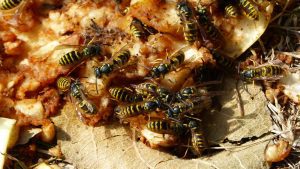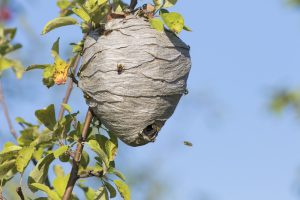FALL YELLOWJACKETS ARE THE WORST!
By Chris Williams on September 7, 2018.
It’s that time of year when, with kids back in school, life should be settling into a quieter routine, a time to enjoy the approach of delightful fall weather – except for the dreaded YELLOWJACKETS!
YELLOWJACKETS HAVE DEVELOPED AN ATTITUDE!

Yellowjackets feeding on an over ripe apple on the ground.
It’s probably no surprise to anyone that yellowjackets become more obnoxious and in-your-face in late summer into fall (see Why Are There So Many Yellowjackets?). There are actually reasons for that. First, there are more yellowjackets now than ever since nests grow exponentially throughout the summer. A single nest could now be home to 4,000 yellowjackets.
Second, the organization of the yellowjackets’ colony is breaking down and their queen is dying. Yellowjacket nests and yellowjacket workers don’t survive through the winter. But to compensate for that, in late summer nests are producing next year’s queens and males to mate with them. Workers are no longer feeding developing larvae, and are instead fighting among themselves. Their foraging is no longer to collect insects for larval food but instead is to find whatever they can. Every wasp for herself! Eventually the existing queen will leave the nest to die and workers will follow.
YOU CAN STILL HAVE YELLOWJACKET NESTS TREATED

Yellowjacket nest in a tree. Shutterstock.
Fall yellowjackets could still be with us for another month or two but you don’t have to hide inside until then. It’s not too late to control troublesome yellowjackets by treating their nests, but this is a job best done by a professional. In fact, eliminating some of those developing queens now should mean fewer new nests around your property next year since these prospective queens leave the nest and hide during the winter and start new nests in the spring (see Got Yellowjackets? Expect More Next Year!). When nests can’t be located, professional trapping of yellowjackets is another option for sensitive sites such as picnic areas, parks, swimming pools, or backyard decks.
MANAGE OUTDOOR YELLOWJACKET FOOD SOURCES
There are other steps you can take, too, to discourage yellowjackets and they mostly involve proper disposal of food garbage and elimination of potential food sources for yellowjackets. It doesn’t take much to attract foraging yellowjackets. When one finds a food source, even a little leftover soda in a can, others are sure to follow.
- When eating outside or barbecuing on the deck, make sure you clean up during and after. Wipe up food spills as they occur. Keep serving dishes covered and serve drinks in cups with lids. After, wipe up meat juices on the grill.
- Use a portable fan when on your deck or patio. The slight breeze is often enough to keep flying insects (yellowjackets and flies, including mosquitoes) away from your food and party.
- Pick up any fallen tree fruits or overripe and rotting vegetables in the garden.
- Don’t leave pet food outdoors (canned pet food is used by pros as a yellowjacket bait!)
- Use wasp guards on your hummingbird feeders.
- Keep garbage cans hosed out, tightly covered, and with a heavy duty plastic liner that is tied off. Store the cans away from outdoor activity areas. If you have outdoor recycling bins, treat them the same way and rinse out containers before disposal.